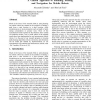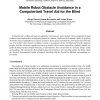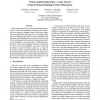ISER
1993
Springer
14 years 7 months ago
1993
Springer
Much of the focus of the research effort in path planning for mobile robots has centred on the problem of finding a path from a start location to a goal location, while minimising...
ICRA
1994
IEEE
14 years 7 months ago
1994
IEEE
A blind traveler walking through an unfamiliar environment, and a mobile robot navigating through a cluttered environment have an important feature in common: both have the kinema...
ICRA
1994
IEEE
14 years 7 months ago
1994
IEEE
An approach is presented for exploring an unknown, arbitrary surface in three-dimensional (3D) space by a mobile robot. The main contributions are (1) an analysis of the capabilit...
ICRA
1993
IEEE
14 years 7 months ago
1993
IEEE
We present an approach for solving the path planning problem for a mobile robot operating in an unknown, three dimensional environment containing obstacles of arbitrary shape. The...
VW
1998
Springer
14 years 7 months ago
1998
Springer
Abstract. This paper presents Webots: a realistic mobile robot simulator allowing a straightforward transfer to real robots. The simulator currently support the Khepera mobile robo...
KI
1998
Springer
14 years 7 months ago
1998
Springer
The control of mobile robots acting autonomously in the real world is one of the long-term goals of the field of artificial intelligence. So far the field lacks methods bridging th...
ECCV
1998
Springer
14 years 7 months ago
1998
Springer
Different applications in the field of vision-based navigation of autonomous mobile robots depend on the degree of knowledge of the environment. Indoor environment applications oft...
ICRA
1998
IEEE
14 years 7 months ago
1998
IEEE
Our research addresses how to integrate exploration and localization for mobile robots. A robot exploring and mapping an unknown environment needs to know its own location, but it...
ICRA
1998
IEEE
14 years 7 months ago
1998
IEEE
This paper presents further developments of the earlier Vector Field Histogram (VFH) method for realtime mobile robot obstacle avoidance. The enhanced method, called VFH+, offers ...
ICRA
1998
IEEE
14 years 7 months ago
1998
IEEE
This paper proposes a hybrid approach to the problem of collision avoidance for indoor mobile robots. The DWA (short for: model-based dynamic window approach) integrates sensor dat...





